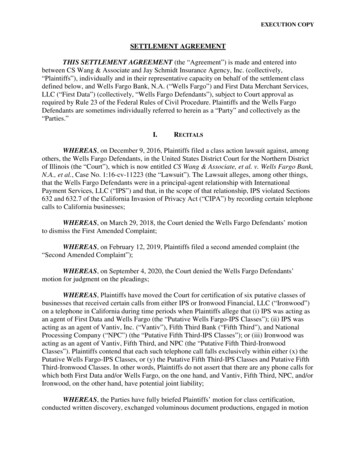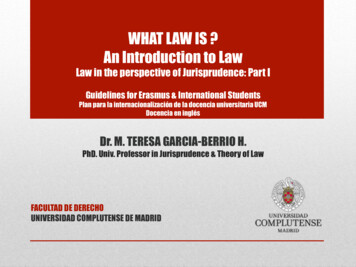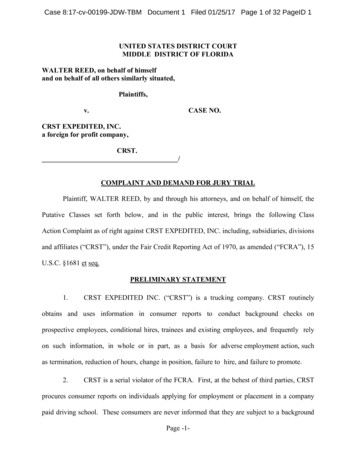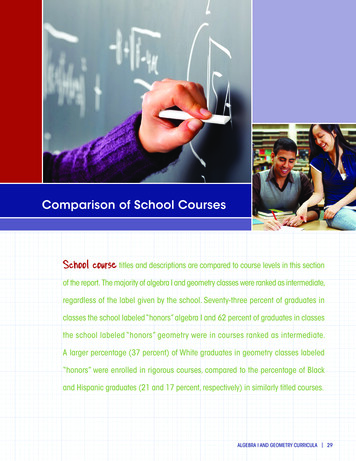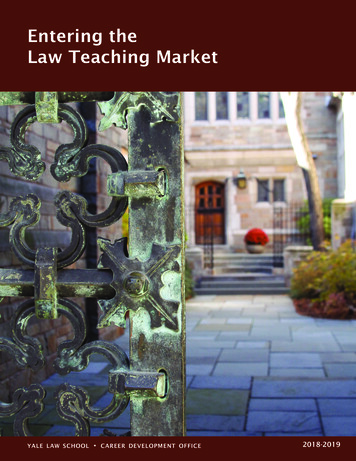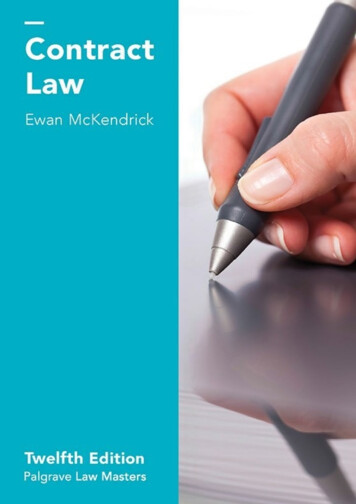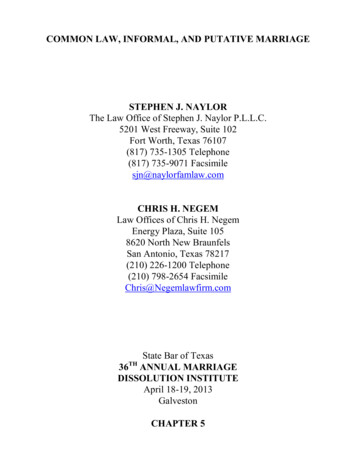
Transcription
COMMON LAW, INFORMAL, AND PUTATIVE MARRIAGESTEPHEN J. NAYLORThe Law Office of Stephen J. Naylor P.L.L.C.5201 West Freeway, Suite 102Fort Worth, Texas 76107(817) 735-1305 Telephone(817) 735-9071 Facsimilesjn@naylorfamlaw.comCHRIS H. NEGEMLaw Offices of Chris H. NegemEnergy Plaza, Suite 1058620 North New BraunfelsSan Antonio, Texas 78217(210) 226-1200 Telephone(210) 798-2654 FacsimileChris@Negemlawfirm.comState Bar of Texas36 ANNUAL MARRIAGEDISSOLUTION INSTITUTEApril 18-19, 2013GalvestonTHCHAPTER 5
STEPHEN J. NAYLORLaw Office Of Stephen J. Naylor, P.L.L.C.5201 West Freeway, Suite 102Fort Worth, TX 76107Telephone: (817) 735-1305Facsimile: (817) 735-9071E-mail: sjn@naylorfamlaw.comEDUCATION:Texas Tech University School of LawJ.D. May 1994Student SenatorOfficer - Christian Legal SocietyOfficer - Criminal Trial Lawyers AssociationRecipient, American Jurisprudence Award in Trial AdvocacyRecipient, American Jurisprudence Award in Products LiabilityTexas Tech UniversityB.B.A. in Management, (summa cum laude) 1990Beta Gamma Sigma Honor SocietyPresident's Honor ListDean's Honor ListAREAS OF PRACTICE:Board Certified-Family Law, Texas Board of Legal SpecializationPROFESSIONAL ACTIVITIES:State Bar Of TexasState Bar Of Texas Family Law SectionTarrant County Bar AssociationTarrant County Family Law Bar AssociationEldon B. Mahon Inn of Court - Barrister (1999-2002, 2008-2009)Pro Bono Committee, State Bar of Texas Family Law Section 2005 to presentCo-Chairman, Pro Bono Committee, State Bar of Texas Family Law Section 2010 to presentFamily Law Practice Manual Revision Committee, State Bar of Texas (2006-2009)Family Law Council of the Family Law Section of the State Bar of Texas 2006 to presentBoard of Directors, Tarrant County Family Law Bar Association (2007-2009)Supreme Court of Texas Uniform Forms Task Force 2011 to presentDirector - Texas Academy of Family Law Specialists 2011 to presentTrustee – Texas Family Law Foundation Board of Trustees 2012 to presentAdjunct Professor, Texas Christian University 2008 to presentPROFESSIONAL AWARDS:Recipient of the Eva Barnes Award, Tarrant County Family Law Bar Association 2012Listed as a Texas Super Lawyer by Texas Monthly Magazine 2004 to presentListed in Fort Worth, Texas Magazine as a Top Family Law Attorney 2004 to present
PUBLICATIONSMediation: When is it Really Over? (with Gary L. Nickelson) 2002 Advanced Family LawCourseCharacterization and Tracing on a Budget (with Gary L. Nickelson)2003 Marriage Dissolution InstituteFamily Law for Fun and Profit (with Gary L. Nickelson) 2003 Advanced Family Law CourseDealing with the Not So Right Client 2004 Marriage Dissolution InstituteThe ABCs of Trying the Simple or Complex Case (with Gary L. Nickelson)2005 Marriage Dissolution InstituteEvidence 2005 Marriage Dissolution InstituteUsing Outside Resources (with Gary L. Nickelson) 2005 Advanced Family Law DraftingIf You Can’t Get It Before the Factfinder, You Can’t Win - Effective and Practical Application ofthe rules of Evidence 2006 Advance Family Law CourseSummary Judgments 2007 Marriage Dissolution InstitutePossession Orders, Including Special Circumstances@ (with G. Thomas Vick, Jr.)2007 Advance Family Law CourseEvidence & Discovery 2008 Marriage Dissolution InstituteShow Me the Money” Advanced Collection Methods 2008 Advance Family Law CourseCourtroom Objections: Proper Methods of Objecting and Otherwise Protecting Your Client inthe Courtroom” (with Kimberly M. Naylor) 2009 Advance Family Law CourseCreative Possession Schedules” (with Kimberly M. Naylor)2010 Advance Family Law Drafting Course“Venue, Standing and Jurisdiction” 2011 Marriage Dissolution 101Evidentiary Silver Bullets” State Bar College 13th Annual Summer School, 2011Case Law Update - SAPCR” (with Jack W. Marr) 2011 Advance Family Law Course“Drafting Motions and Orders in Family Law Cases” 2011 Advanced Family Law DraftingCourse“Characterization and Tracing” 2012 Marriage Dissolution 101“Child Support Enforcement” 2012 Advanced Family Law Course“Cross Examination of Experts” 2013 Sex, Drugs & Surveillance
SPEAKER AND LECTURERSpeaker at Family Law Essentials Seminar, presented by the Family Law SectionSeptember 2003, Lubbock, TXSpeaker at 2003 Family Law Seminar, presented by the Family Law SectionOctober 2003, Wichita Falls, TXSpeaker at 2004 Marriage Dissolution Institute, April 2004, Fort Worth, TXSpeaker at 2004 Annual Meeting, June 2004, San Antonio, TXSpeaker at 2004 Family Law Boot Camp, presented by the Family Law SectionAugust 2004, San Antonio, TXSpeaker at LAU Seminar, presented by the Legal Assistants DivisionSeptember 2004, Fort Worth, TXSpeaker at Family Law Essentials for 2000 or Free, presented by the Pro Bono Committee ofthe Family Law Section, September 2004, Laredo, TXSpeaker at 2005 Marriage Dissolution Institute, April 2005, Galveston, TXSpeaker at 2005 Annual Meeting, June 2005, Dallas, TXCourse Director, Family Law Basic Training, by the Family Law Section, August 2005, Dallas,TXSpeaker at 2005 Family Law Seminar, presented by the Family Law SectionSeptember 2005, Eagle Pass, TXSpeaker at 2006 Advanced Family Law Course, August 2006, San Antonio, TXCourse Director, Family Law Essentials for 2000 or Free, presented by the Pro BonoCommittee of the Family Law Section, April 2007, Mineral Wells, TXSpeaker at 2007 Marriage Dissolution Institute, May 2007, El Paso, TXSpeaker, Family Law Essentials for 2000 or Free, presented by the Pro Bono Committee ofthe Family Law Section, October 2007, Laredo, TXCourse Director, Family Law Essentials for 2000 or Free, presented by the Pro BonoCommittee of the Family Law Section, April 2008, Wichita Falls, TXSpeaker at 2008 Advanced Family Law Course, August 2008, San Antonio, TXModerator of a panel at 2009 Marriage Dissolution Institute, April 2009, Fort Worth, TX“Psychology of a Possession Order”Moderator of a panel at the 9th Annual Family Law On The Front Lines, June 2009, SanAntonio, TX, “When You Play, You May Pay! Paternity Fraud – The Newest Form of BirthControl”
Speaker, 2009 Advanced Family Law Course, August 2009, Dallas, TXCourse Director, Pro Bono Family Law Seminar, presented by the Family Law SectionOctober 2009, Eagle Pass, TXSpeaker, Parent-Child Relationships: Critical Thinking for Critical Issues, January, 2010,Austin, TXCourse Director and Speaker, Pro Bono Family Law Seminar, presented by the Family LawSectionSeptember 2010, Sherman, TXCourse Director, 2010 Advanced Family Law Course, August 2010, San Antonio, TXSpeaker, 2010 Advanced Family Law Drafting Course, December 2010, Houston, TXSpeaker, 2011 Marriage Dissolution 101 Course, April 2011, Austin, TXSpeaker, State Bar College 13th Annual Summer School, July 2011, Galveston, TXSpeaker, 2011 Advanced Family Law Course, August 2011, San Antonio, TXSpeaker, 2011 Advanced Family Law Drafting Course, December 2011, Dallas, TXSpeaker, 2012 Marriage Dissolution 101, April 2012, Dallas, TXSpeaker, 2012 Advanced Family Law Course, August 2012, Houston, TXSpeaker, 2013 Sex, Drugs & Surveillance, January 2013, Houston, TX
CHRIS H. NEGEMAttorney at Law8620 North New Braunfels, Suite 105San Antonio, Texas 78217OFFICE: (210) 226-1200 FAX: (210) 798-2654Email: N B.A. Texas A&M University, 1980; J.D. Mississippi College, School of Law, 1990; Managing Editor, Mississippi College Law Review - 1989-1990; and International Legal Fraternity-Phi Delta Phi.MILITARY SERVICE United States Army (Active Duty, January 1974-December 1976) - Honorable Discharge.PROFESSIONAL ACTIVITIES Director, San Antonio Family Lawyers Association, 2009; Board Certified in Family Law, 1997 to date; Past Member, Family Law Council, State Bar of Texas; Past Chair, Legal Assistants Committee, Family Law Section, State Bar of Texas; Past Member, Pro Bono Committee, Family Law Section, State Bar of Texas; Member, Texas Academy of Family Law Specialists; Past Panel Chair, District 10C Grievance Committee; Member, San Antonio Bar Association; Member, Family Law Section, State Bar of Texas; and Fee Dispute Committee for the San Antonio Bar Association, 1995-1996 and 1996-1997.TECHNICAL AND PROFESSIONAL LICENSES Admitted to the Bar in Texas in 1990; and United States Federal District Court, Western and Northern Districts of Texas, 1990.LAW RELATED PUBLICATIONS, ACADEMIC APPOINTMENTS AND HONORS Martindale-Hubbell, AV rating 2005, 2006, 2007, 2008, 2009, 2010, 2011 and 2012 Texas Monthly Super Lawyer; 2004 Who’s Who in Law & Accounting as featured in the San Antonio Business Journal; “San Antonio’s Best Lawyers,” as featured in Scene in S.A. magazine, August 2004, 2005,2006, 2007, 2008, 2009, 2010 and 2011; “San Antonio’s Top Divorce Lawyers” as featured in Scene in S.A. magazine, 2003; 1996 Outstanding Young Family Lawyer, San Antonio, Texas; 1990 Outstanding Young Men in America; Speaker, Temporary Orders Hearing, 2012 Advanced Family Law Course; Speaker, Valuation of Property, 2010 Advanced Family Law Course; Author, Speaker, More Money, Less Stress: Law Office Management and Technology,2010 Advanced Family Law Course; Author, Speaker, Closing the File, May 5, 2010 – Marriage Dissolution Institute, SanAntonio, Texas;
CHRIS H. NEGEMPage 2 Speaker, Buying a Business: Capital Intensive v. Asset Based, March 26, 2009 –Representing Small Business Course, Dallas, Texas;Author, Speaker, Valuation, April 17, 2008 – Marriage Dissolution Seminar, Galveston,Texas;Author, Speaker, How to Help the Judge Rule in Your Favor: Preparing for TemporaryOrders Hearing - May 9, 2007 - Marriage Dissolution Seminar, El Paso, Texas, Enhancingyour Legal Practice with the Attorney/Paralegal Team;Speaker, Maximizing the Take at a Final Property Hearing - Family Law Essentials for 2000 or Free-April 20, 2007, Mineral Wells, Texas - The Pro Bono Committee of the FamilyLaw Section of the State Bar of Texas;Moderator/Coordinator, Family Law Essentials for 2000 or Free - September 30, 2005,Eagle Pass, Texas - The Pro Bono Committee of the Family Law Section of the State Bar ofTexas;Moderator, Speaker, Effective Mediation at the Next Level, April 1, 2004, San Antonio,Texas - San Antonio Family Lawyers Association;Author, Speaker, Identifying, Characterizing and Valuing the Marital Estate: AnOverview - October 1, 2003, San Antonio, Texas - Legal Assistants University;Moderator/Coordinator, Family Law Essentials for 2000 or Free, September 11, 2003,Lubbock, Texas - The Pro Bono Committee of the Family Law Section of the State Bar ofTexas;Author, Speaker, The Trial of a Family Law Case and Ethical Conduct, January 31, 2001Texas General Practice and Ethics Institute - Stromar Educational Services, Inc.;Author, Speaker, The Trial of a Family Law Case and Ethical Conduct, September 26,2000 - Stromar Educational Services, Inc.;Author, Speaker, Working with Divorce Clients and Opposing Counsel, Sweet, Nice andPolite, January 28, 2000 - Texas Family Law Practice for Paralegals;Co-Author, Speaker, The Trial of a Family Law Case and Ethical Conduct, January 26,2000 - Stromar Educational Services, Inc.;Co-Author, Speaker, Evidence, October 27, 1999 - Stromar Educational Services, Inc.Co-Author, What they don’t teach you in Law School about setting and CollectingAttorney’s Fees, 1997 Advanced Family Law Course;Co-Author, Practical Tips from the Top, 1996 Marriage Dissolution Institute; andCo-Author, Express Trusts in Divorce, 1995 Advanced Family Law Course.
Common Law, Informal, and Putative MarriageChapter 5TABLE OF CONTENTSI.INTRODUCTION. 1II.CHANGING DEMOGRAPHICS . 1A.United States Demographics . 1B.Texas Demographics . 1C.Interesting and Relevant Facts . 1III.MARRIAGE . 2A.Every Marriage Presumed Valid . 2B.Legal Capacity To Marry. 2IV.REQUIREMENTS FOR ESTABLISHING AN INFORMAL MARRIAGE . 2V.DECLARATION AND REGISTRATION OF INFORMAL MARRIAGE . 2VI.RECORDING OF CERTIFICATE OF DECLARATION OF INFORMAL MARRIAGE . 3A.Agreement To Be Married. 4(1)Proving Intent . 4(2)Express or Implied Agreement . 5(3)Direct or Circumstantial Evidence . 5B.Living Together as Husband and Wife . 5VIII.THE BURDEN OF PROOF. 7IX.THE EFFECT OF AN INFORMAL MARRIAGE ON THE PARTIES . 7X.DEFENDING A CLAIM OF COMMON LAW MARRIAGE . 7A.Interim Motions . 8B.The Answer . 8C.Plea in Abatement . 8D.Discovery . 8E.Finalizing the Case . 9XI.PUTATIVE MARRIAGES . 9A.Purpose of Putative Marriage Doctrine . 9B.Conditions Giving Rise to a Putative Marriage . 9C.Requirement of Good Faith . 9D.Impediments . 10E.Termination of a Putative Marriage . 10F.Other Rights of a Putative Spouse . 11(1)Inheritance Rights . 11(2)Homestead Rights . 11XII.CONCLUSION . 11i
Common Law, Informal, and Putative MarriageChapter 5COMMON LAW, INFORMAL, ANDPUTATIVE MARRIAGESThis 7.4 million unmarried household represents anincrease of 1.9 million from the 2000 census and 4.2million from the 1990 census.I.INTRODUCTIONChanging lifestyles in the United States havecaused many of us to see a drastic increase in casescoming through our doors where the main question iswhether or not there is a common law or informalmarriage. We know the basic requirements necessaryto establish a common law marriage, but there are manyvariables outside the basics that may determine thevalidity of such a marriage claim. This paper isintended to provide you with not only the tools,statutes, and case law you’ll need to either defend orprosecute a common law marriage case; but also anoverview of the changing demographics that have led tothis increase. (All figures are from the U.S. CensusBureau unless otherwise noted.)B.Texas DemographicsIn 2000, Texas had a total of 7,393,354households. Of those 7.3 million households, 327,246were classified as unmarried partner households. Inother words, 7.6% of all coupled households wereoccupied by unmarried partners. 284,334 of thoseunmarried partner households were occupied byopposite sex couples.In 2010, Texas had a total of 8,922,933 coupledhouseholds. Of those 8.9 million households, 535,376were classified as unmarried partner households; anincrease of 208,130 households. 463,993 of thoseunmarried partner households were occupied byopposite sex couples.The majority of the unmarried partner householdsin Texas were in metropolitan areas. The average ageof the unmarried couples was 35.6 for the maleoccupant and 33.6 for the female occupant.II. CHANGING DEMOGRAPHICSA. United States DemographicsIn the 1960 census there was a total of 450,000households in the United States that were categorizedas persons who were living together, but not married orrelated. Because this category was not broken downfurther, this number includes housemates/roommates,roomers or boarders, and unmarried partners.In 1990, the category, “unmarried partner” wasadded to the questionnaire to measure the growingtendency for couples to live together before gettingmarried. An unmarried partner is defined by the U.S.Census Bureau as “people who were sharing livingquarters and who had a close personal relationship witheach other.” Contrast that with another new category;people who were sharing the same living quarters butwere doing so just to share living expenses, wereoffered the opportunity to identify themselves asroommates or housemates.The 1990 U.S. Census identified a total of 91.9million households in the United States. Of those 91.9million, 3.2 million households identified themselvesunder the new category as unmarried partners.The 2000 U.S. Census identified a total of 105.5million households in the United States. 5.5 million ofthose households identified themselves as unmarriedpartners.This was an increase of 2.3 millionhouseholds in just ten (10) years. [A tenfold increase inthe number of unmarried households from the 1960census.] 4.9 million of those 5.5 million were furthercategorized as opposite sex households.In 2010, the U. S. Census Bureau registered a totalof 116.7 million households in the United States. 7.4million of those households identified themselves asunmarried partner households with 6.8 million of thosewere further categorized as opposite sex households.C.Interesting and Relevant FactsIn 2000, Pamela Smock conducted a study ofunmarried partner households and she published herfindings in the Annual Review of Sociology. Some ofher more interesting and relevant findings to ourpractice are as follows: 21 % of unmarried partner households havechildren together.45.4% of unmarried partner households saidthey live with at least one biological child ofeither partner.The majority of couples who get marriedtoday cohabitated first.75% of unmarried partners plan to marry theirpartner.55% of unmarried partners do marry within 5years.However, 40% of those unmarried partnersbreak up within that same 5 year period.Smock, Pamela 2000, “Cohabitation in the UnitedStates.” Annual Review of Sociology.As you can see, the number of unmarried partnerhouseholds has steadily increased since the U.S. CensusBureau began tracking this category in 1990. Whenyou combine this increase with the number ofunmarried partners that have children together and that40% of them break up after 5 years, it’s easier tounderstand why we are seeing the increase in commonlaw, informal, and putative marriage claims in Texas.1
Common Law, Informal, and Putative MarriageChapter 5stepparent of the other; and lastly, that theyare not a son or daughter of a parent’s brotheror sister, of the whole or half blood or byadoption. Texas Family Code §2.004.III. MARRIAGEA. Every Marriage Presumed ValidThe policy of the State of Texas regarding thevalidity of any marriage, whether ceremonial, commonlaw, or putative, is set forth in Section 1.101 of theTexas Family Code, which provides the following:IV. REQUIREMENTS FOR ESTABLISHING ANINFORMAL MARRIAGEAlthough Texas has long recognized common lawmarriages, the acceptance of this concept has beendescribed as “grudging.” Russell v. Russell, 865 S.W.2d929, 931 (Tex. 1993); see also Texas Employers’Insurance Ass’n v. Elder, 274 S.W.2d 144, 147 (Tex.Civ. App. – Fort Worth 1954), aff’d on other grounds,155 Tex. 27, 282 S.W.2d 371 (1955) “The law does notfavor, but merely tolerates common-law marriages ” Therefore, although Texas has not been able toabolish common law marriages, courts closelyscrutinize these claims. See Russell, 865 S.W.2d at932 “In a society in which non-marital cohabitation forextended periods of time is far more common than itonce was, the fact finder will have to weigh theevidence of a tacit agreement more carefully than in thepast.”Texas Family Code §2.401 establishes therequirements to prove an informal marriage. Inrelevant, part that section states as follows:In order to promote the public health andwelfare and to provide the necessary records,this code specifies detailed rules to befollowed in establishing the marriagerelationship. However, in order to providestability for those entering into the marriagerelationship in good faith and to provide foran orderly determination of parentage andsecurity for the children of the relationship, itis the policy of this state to preserve anduphold each marriage against claims ofinvalidity unless a strong reason exists forholding the marriage void or voidable.Therefore, every marriage entered into in thisstate is presumed valid unless expressly madevoid by Chapter 6 [Suit for Dissolution ofMarriage] or unless expressly made voidableby Chapter 6 and annulled as provided by thatchapter.(a) In a judicial, administrative, or otherproceeding, the marriage of a man andwoman may be proved by evidence that:B.Legal Capacity To MarryBefore anyone can enter into a valid marriage inTexas, whether ceremonial or informal, they mustpossess the legal capacity to marry. In order to establisha valid marriage in Texas, the parties must establish thefollowing:(1)a declaration of their marriage has beensigned as provided by this subchapter; or(2) the man and woman agreed to bemarried and after the agreement theylived together in this state as husbandand wife and there represented to othersthat they were married.(1) That the marriage is to be between a man anda woman Texas Family Code §2.001 and§2.401;(2) That neither party has been divorced withinthe past 30 days Texas Family Code §2.004;(3) That neither party is presently married. TexasFamily Code §2.004;(4) That each party is at least 18 years of ageTexas Family Code §2.101, unless theunderage party has secured an order from thecourt granting permission to marry TexasFamily Code §2.103, or has proof of parentalconsent Texas Family Code §2.102; and,(5) That the parties are not related as an ancestoror descendant, by blood or adoption; that theyare not brother or sister, of the whole or halfblood or by adoption; that are not related by aparent's brother or sister by whole or halfblood, or by adoption; that they are not theson or daughter of a brother or sister, of thewhole or half blood or by adoption; that theyare not the current or former stepchild or(b) If a proceeding in which a marriage is to beproved as provided by Subsection (a)(2) isnot commenced before the secondanniversary of the date on which the partiesseparated and ceased living together, it isrebuttably presumed that the parties did notenter into an agreement to be married.Thus, this subsection provides an evidentiarypresumption of no marriage if no suit for divorceclaiming an informal marriage is filed within two yearsof the parties' separation.V.DECLARATION AND REGISTRATION OFINFORMAL MARRIAGEThe requirements necessary to establish aninformal marriage pursuant by declaration as provided2
Common Law, Informal, and Putative MarriageChapter 5in Texas Family Code §2.401(a)(1) are contained inTexas Family Code §2.402. That section provides asfollows:OTHER PARTY I HAVE NOT BEENMARRIEDTOANYOTHERPERSON. THIS DECLARATION ISTRUE AND THE INFORMATION INIT WHICH I HAVE GIVEN ISCORRECT.”;(6) spaces immediately below the printeddeclaration and oath for the parties’signatures; and(7) a certificate of the county clerk that theparties made the declaration and oathand the place and date it was made.(a) A declaration of informal marriage must besigned on a form prescribed by the bureau ofvital statistics and provided by the countyclerk. Each party to the declaration shallprovide the information required in the form.(b) The declaration form must contain:(1) a heading entitled "Declaration andRegistration of Informal Marriage,County, Texas";(2) spaces for each party's full name,(including the woman's maiden surname,address, date of birth, place of birth,including city, county, and state, andsocial security number, if any;(3) a space for indicating the type ofdocument tendered by each party asproof of age and identity;(4) printed boxes for each party to check"true" or "false" in response to thefollowing statement: "The other party isnot related to me as:VI. RECORDING OF CERTIFICATE OFDECLARATIONOFINFORMALMARRIAGESection 2.404 of the Texas Family Code outlinesthe procedures the county clerk should follow forfinalization of the declaration of marriage. Section2.404 provides as follows:(a) The county clerk shall:(1)determine that all necessary informationis recorded on the declaration ofinformal marriage form and that allnecessary documents are submitted tothe clerk;(2) administer the oath to each party to thedeclaration;(3) have each party sign the declaration inthe clerk's presence; and(4) execute the clerk's certificate to thedeclaration.(A) an ancestor or descendant, by bloodor adoption;(B) a brother or sister, of the whole orhalf blood or by adoption;(C) a parent's brother or sister, of thewhole or half blood or by adoption;or(D) a son or daughter of a brother orsister, of the whole or half blood orby adoption;(E) a current or former stepchild orstepparent; or(F) a son or daughter of a parent’sbrother or sister, of the whole orhalf blood or by adoption.”(a-1) On the proper execution of the declaration,the clerk may:(1) prepare a certificate of informal marriage;(2) enter on the certificate the names of thepersonsdeclaring their informalmarriage and the date the certificate ordeclaration is issued; and(3) record the time at which the certificate ordeclaration is issued.(5) a printed declaration and oath reading: "ISOLEMNLY SWEAR (OR AFFIRM)THAT WE, THE UNDERSIGNED,ARE MARRIED TO EACH OTHERBY VIRTUE OF THE FOLLOWINGFACTS: ON OR ABOUT (DATE) WEAGREED TO BE MARRIED, ANDAFTER THAT DATE WE LIVEDTOGETHER AS HUSBAND ANDWIFE AND IN THIS STATE WEREPRESENTED TO OTHERS THATWE WERE MARRIED. SINCE THEDATE OF MARRIAGE TO THE(b) The county clerk may not certify thedeclaration or issue or record the certificate ofinformal marriage or declaration if:(1)either party fails to supply anyinformation or provide any documentrequired by this subchapter;(2) either party is under 18 years of age; or3
Common Law, Informal, and Putative Marriage(3)Chapter 5either party checks "false" in response tothe statement of relationship to the otherparty.A.Agreement To Be MarriedTo establish a common law marriage the evidencemust show that the parties intended to have a present,immediate, and permanent marital relationship, and thatthey did in fact agree to be husband and wife presently– not in the future. Winfield v. Renfro, 821 S.W.2d 640,645 (Tex.App.-Houston [1st Dist.] 1991, writ denied.)(citing Rodriguez v. Avalos, 567 S.W.2d 85, 86 (Tex.Civ. App. - El Paso 1978, no writ). “To establish thiselement, the evidence must show the parties intended tohave a present, immediate, and permanent maritalrelationship and that they agreed to be husband andwife” Id. See also Gary v. Gary, 490 S.W.2d 929, 934(Tex. Civ. App.-Tyler 1973, writ ref’d n.r.e.) whichstated “Each of the elements is necessary, and it isparticularly essential that the parties mutually agree thatthey would then and thenceforth be husband and wifeand that the following cohabitation be on the faith ofthis mutual agreement and promise.”(c) On execution of the declaration, the countyclerk shall record the declaration or certificateof informal marriage, deliver the original ofthe declaration to the parties, deliver theoriginal of the certificate of the informalmarriage to the parties, if a certificate wasprepared, and send a copy of the declarationof informal ma
Fort Worth, TX 76107 . Telephone: (817) 735-1305 . Facsimile: (817) 735-9071 . E-mail: sjn@naylorfamlaw.com . EDUCATION: Texas Tech University School of Law . . Tarrant County Family Law Bar Association (2007-2009) Supreme Court of Texas Uniform Forms Task Force 2011 to present .
